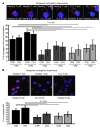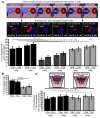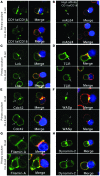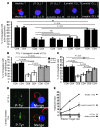Chronic lymphocytic leukemia T cells show impaired immunological synapse formation that can be reversed with an immunomodulating drug
- PMID: 18551193
- PMCID: PMC2423865
- DOI: 10.1172/JCI35017
Chronic lymphocytic leukemia T cells show impaired immunological synapse formation that can be reversed with an immunomodulating drug
Abstract
Cancer is associated with immune deficiency, but the biologic basis of this is poorly defined. Here we demonstrate that impaired actin polymerization results in CD4+ and CD8+ T cells from patients with chronic lymphocytic leukemia (CLL) exhibiting defective immunological synapse formation with APCs. Although this synapse dysfunction was in part a result of the CLL cells having poor APC function, defective actin polymerization was also identified in T cells from patients with CLL. We further demonstrate that, following contact with CLL cells, defects in immune synapse formation were induced in healthy allogeneic T cells. This required direct contact and was inhibited by blocking adhesion molecules on CLL B cells. In T cells from patients with CLL and in T cells from healthy individuals that had been in contact with CLL cells, recruitment of key regulatory proteins to the immune synapse was inhibited. Treatment of autologous T cells and CLL cells with the immunomodulating drug lenalidomide resulted in improved synapse formation. These results define what we believe to be a novel immune dysfunction in T cells from patients with CLL that has implications for both autologous and allogeneic immunotherapy approaches and identifies repair of immune synapse defects as an essential step in improving cancer immunotherapy approaches.
Figures







Similar articles
-
Multiple inhibitory ligands induce impaired T-cell immunologic synapse function in chronic lymphocytic leukemia that can be blocked with lenalidomide: establishing a reversible immune evasion mechanism in human cancer.Blood. 2012 Aug 16;120(7):1412-21. doi: 10.1182/blood-2012-02-411678. Epub 2012 Apr 30. Blood. 2012. PMID: 22547582 Free PMC article.
-
Lenalidomide Induces Interleukin-21 Production by T Cells and Enhances IL21-Mediated Cytotoxicity in Chronic Lymphocytic Leukemia B Cells.Cancer Immunol Res. 2016 Aug;4(8):698-707. doi: 10.1158/2326-6066.CIR-15-0291. Epub 2016 Jun 10. Cancer Immunol Res. 2016. PMID: 27287425 Free PMC article.
-
Chronic lymphocytic leukemia cells induce defective LFA-1-directed T-cell motility by altering Rho GTPase signaling that is reversible with lenalidomide.Blood. 2013 Apr 4;121(14):2704-14. doi: 10.1182/blood-2012-08-448332. Epub 2013 Jan 16. Blood. 2013. PMID: 23325833 Free PMC article.
-
Vaccine- and immune-based therapy in chronic lymphocytic leukemia.Semin Oncol. 2006 Apr;33(2):220-9. doi: 10.1053/j.seminoncol.2005.12.012. Semin Oncol. 2006. PMID: 16616069 Review.
-
How does lenalidomide target the chronic lymphocytic leukemia microenvironment?Blood. 2014 Oct 2;124(14):2184-9. doi: 10.1182/blood-2014-05-578286. Epub 2014 Aug 26. Blood. 2014. PMID: 25161268 Review.
Cited by
-
Immune reconstitution in chronic lymphocytic leukemia.Curr Hematol Malig Rep. 2012 Mar;7(1):13-20. doi: 10.1007/s11899-011-0106-x. Curr Hematol Malig Rep. 2012. PMID: 22231031 Free PMC article. Review.
-
Lenalidomide in the treatment of chronic lymphocytic leukemia.Adv Hematol. 2012;2012:393864. doi: 10.1155/2012/393864. Epub 2012 May 8. Adv Hematol. 2012. PMID: 22851972 Free PMC article.
-
Chronic lymphocytic leukemia cells diversify and differentiate in vivo via a nonclassical Th1-dependent, Bcl-6-deficient process.JCI Insight. 2016 Apr 7;1(4):e86288. doi: 10.1172/jci.insight.86288. JCI Insight. 2016. PMID: 27158669 Free PMC article.
-
Initial treatment of CLL: integrating biology and functional status.Blood. 2015 Jul 23;126(4):463-70. doi: 10.1182/blood-2015-04-585067. Epub 2015 Jun 11. Blood. 2015. PMID: 26065656 Free PMC article. Review.
-
Enhanced Costimulatory Signaling Improves CAR T-cell Effector Responses in CLL.Cancer Res Commun. 2022 Sep 30;2(9):1089-1103. doi: 10.1158/2767-9764.CRC-22-0200. eCollection 2022 Sep. Cancer Res Commun. 2022. PMID: 36922932 Free PMC article.
References
Publication types
MeSH terms
Substances
Grants and funding
LinkOut - more resources
Full Text Sources
Other Literature Sources
Research Materials
Miscellaneous

